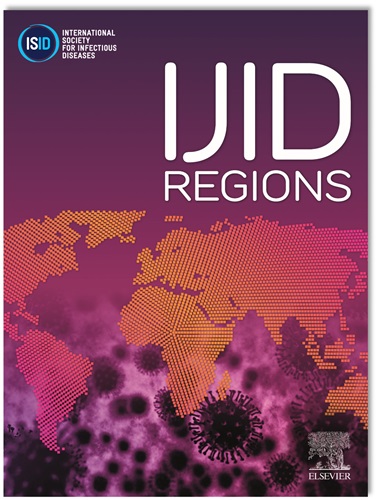Antibacterial Activity of Ceftazidime-avibactam against carbapenem-resistant non-fermenters Gram-negative bacteria: a cross-sectional study from a tertiary care hospital
IF 4.8
2区 医学
Q1 INFECTIOUS DISEASES
引用次数: 0
Abstract
Introduction
Ceftazidime-avibactam (CAZ-AVI) is an innovative combination of the non-ß-lactam ß-lactamase inhibitor avibactam and the extended-spectrum ceftazidime. This combination is effective in treating infections resulted frommultidrug resistant (MDR) Gram-negative bacteria. Therefore, the present study was done to determine the efficacy of CAZ-AVI in carbapenem-resistant against non-fermenters Gram-negative bacteria.
Materials and Methods
The present study was done at a tertiary care hospital in Lahore, Pakistan over the period of 2 years. Different clinical samples were processed according to standard microbiological techniques. Confirmation of bacterial isolates was done by different biochemical tests. Antimicrobial sensitivity testing was done onVitek 2® automated system. CAZ-AVI sensitivity testing was performed for carbapenem-resistant isolates on Meuller Hamilton (MH) agar according to Clinical and Laboratory Standard institute (CLSI) guidelines.
Results
CAZ-AVI was 100% sensitive in carbapenem sensitive isolates. Among non-fermenters, highest resistance against CAZ-AVI was found in Acinetobacterspp. (90.8%) while 75% resistance was observed in P. aeruginosa isolates. Maximum number of isolates were collected from wound (35%) followed by pus (16.8%).
Discussion
In our study, 66.7% resistance was observed against CAZ-AVI among the isolates of carbapenem resistant P. aeruginosa while only 33.3% isolates were found to be susceptible. Similar to our results, reduced susceptibility rate of P. aeruginosa was also reported from several other countries. Lowest susceptibility rates were observed in Romania which was22.2%, 23.1% in Latvia/Lituania and 39.4% susceptibility rate was reported from Ukraine[19]. These results were in accordance with our findings. Contradiction to our results, a study conducted in 2018, reported only 2.9% resistance against CAZ-AVI among P. aeruginosa isolates but the isolates were carbapenem sensitive[20].However, several other studies reported higher resistance rates of 50.9% and 48.2% especially when the isolates were extensively drug resistant or resistant to carbapenems respectively[21]. Moreover, it was also found that MBL-positive isolates also showed >95% resistance rate against ceftazidime-avibactam[22, 23].
Our study reported 74.7% resistance in A. baumanii against CAZ-AVI, consistent to our results, a study conducted by Sader et al in 2015 reported 68.8% resistance of CAZ-AVI in Acinetobacter isolates. Higher resistance was observed in isolates collected from intensive care units (ICUs) which was 73.6%[24].Moreover, MDR and blaOXA-51 gene carrying isolates were found to be completely resistant against CAZ- AVI[25]. Another study conducted on cancer patients reported 57.1% resistance of Acinetobacter spp. against CAZ-AVI. Likewise, several other antimicrobial agents were found to be of moderate to poor efficacy against Acinetobacter spp[26].
Conclusion
CAZ-AVI was considered a good option for the treatment of infections caused by XDR and MDR Gram negative rods. However, its effectiveness against non-fermenters is less as compared to othermembers of Gram-negative bacteria. Moreover, the increasing resistance rate against CAZ-AVI associated with CR needs to be noted.
头孢他啶-阿维巴坦对耐碳青霉烯非发酵革兰氏阴性菌的抑菌活性:来自三级医院的横断面研究
头孢他啶-阿维巴坦(CAZ-AVI)是由非ß-内酰胺ß-内酰胺酶抑制剂阿维巴坦与广谱头孢他啶的创新组合。这种组合对治疗由多重耐药(MDR)革兰氏阴性细菌引起的感染有效。因此,本研究旨在确定CAZ-AVI对碳青霉烯耐药抗非发酵革兰氏阴性菌的效果。材料和方法本研究在巴基斯坦拉合尔的一家三级保健医院进行,为期2年。根据标准微生物学技术对不同的临床样品进行处理。通过不同的生化试验对分离的细菌进行确证。抗菌药物敏感性测试在vitek 2®自动化系统上完成。根据临床和实验室标准协会(CLSI)指南,对碳青霉烯耐药分离株在MH琼脂上进行CAZ-AVI敏感性试验。结果scaz - avi对碳青霉烯类敏感菌株的敏感性为100%。在非发酵菌中,对CAZ-AVI的抗性最高的是不动杆菌。耐药率为90.8%,铜绿假单胞菌耐药率为75%。伤口感染最多(35%),脓液次之(16.8%)。在我们的研究中,碳青霉烯类耐药P. aeruginosa对CAZ-AVI的耐药率为66.7%,而敏感株仅为33.3%。与我们的结果相似,其他几个国家也报道了铜绿假单胞菌的敏感性降低。罗马尼亚的易感性最低,为22.2%,拉脱维亚/立陶宛为23.1%,乌克兰为39.4%。这些结果与我们的发现一致。与我们的研究结果相矛盾的是,2018年的一项研究发现,铜绿假单胞菌对CAZ-AVI的耐药性只有2.9%,但对碳青霉烯类药物敏感。然而,其他一些研究报告的耐药率分别为50.9%和48.2%,特别是当分离株对碳青霉烯类广泛耐药或耐药时[10]。此外,还发现mbl阳性分离株对头孢他啶-阿维巴坦的耐药率为95%[22,23]。我们的研究报告鲍曼不动杆菌对CAZ-AVI的耐药性为74.7%,与我们的结果一致,Sader等人在2015年的研究报告不动杆菌分离株对CAZ-AVI的耐药性为68.8%。在重症监护病房(icu)收集的分离株中观察到较高的耐药性,为73.6%[24]。此外,MDR和携带blaOXA-51基因的分离株对CAZ- AVI[25]完全耐药。另一项针对癌症患者的研究报告,不动杆菌对CAZ-AVI的耐药率为57.1%。同样,其他几种抗菌药物对不动杆菌bbb的疗效中等或较差。结论caz - avi是治疗XDR和MDR革兰氏阴性棒感染的良好选择。然而,与革兰氏阴性菌的其他成员相比,它对非发酵菌的有效性较低。此外,需要注意的是,与CR相关的CAZ-AVI耐药率增加。
本文章由计算机程序翻译,如有差异,请以英文原文为准。
求助全文
约1分钟内获得全文
求助全文
来源期刊
CiteScore
18.90
自引率
2.40%
发文量
1020
审稿时长
30 days
期刊介绍:
International Journal of Infectious Diseases (IJID)
Publisher: International Society for Infectious Diseases
Publication Frequency: Monthly
Type: Peer-reviewed, Open Access
Scope:
Publishes original clinical and laboratory-based research.
Reports clinical trials, reviews, and some case reports.
Focuses on epidemiology, clinical diagnosis, treatment, and control of infectious diseases.
Emphasizes diseases common in under-resourced countries.

 求助内容:
求助内容: 应助结果提醒方式:
应助结果提醒方式:


